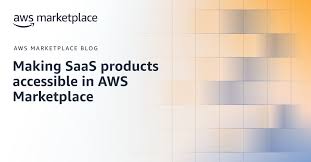In the rapidly growing world of cloud-based software, getting your SaaS (Software-as-a-Service) product into the hands of enterprise buyers requires more than just great technology. One of the most effective distribution channels available to independent software vendors (ISVs) today is the AWS Marketplace.
The AWS Marketplace is a curated digital catalog where businesses can find, test, and deploy software solutions that run on Amazon Web Services. For SaaS providers, listing your product in the AWS Marketplace means greater visibility, easier procurement for customers, and streamlined billing—all under the trusted AWS umbrella.
This article breaks down what it takes to make your SaaS product accessible in AWS Marketplace, why it matters, and how to succeed once you’re there.
🔹 Why List Your SaaS Product in AWS Marketplace?
1. Massive Reach and Trust
With over 330,000 active customers and thousands of new deployments each month, AWS Marketplace offers instant access to a global audience of AWS users who are already in buying mode.
2. Streamlined Procurement
Enterprise buyers can purchase SaaS solutions through their existing AWS accounts, reducing vendor onboarding time, procurement complexity, and legal hurdles.
3. Consolidated Billing
Buyers receive a single invoice from AWS, including your SaaS product charges. This makes budgeting and finance management easier for customers—and more attractive for CFOs.
4. Co-Sell Opportunities
Once listed, you can participate in the AWS ISV Accelerate Program, a co-selling initiative that connects you with AWS sales teams and customers.
5. Pay-as-you-go Pricing Support
You can offer flexible pricing models, including subscriptions, usage-based billing, or free trials, to fit various customer needs.
🔹 Types of SaaS Listings Supported by AWS Marketplace
There are two primary delivery options for SaaS in AWS Marketplace:
1. SaaS Subscriptions
Customers subscribe and are billed based on usage (e.g., number of users, data volume, API calls). Integration with AWS Metering Service is required.
2. SaaS Contracts
Customers commit to a fixed price for a specific term (e.g., 1-year or 3-year contracts). This supports more traditional procurement workflows.
Some products may support both pricing models to attract a wider customer base.
🔹 Key Steps to Listing Your SaaS Product
To make your product available in AWS Marketplace, follow these high-level steps:
✅ 1. Register as a Seller
- Sign up for an AWS Marketplace Management Portal (AMMP) account.
- Provide tax and banking information.
- Choose your company’s legal and public seller profile.
✅ 2. Prepare Your SaaS Product
- Ensure your product is cloud-native and securely hosted (AWS hosting preferred, but not mandatory).
- Identify metering dimensions (e.g., per user, per API call, GB stored).
- Design your authentication and entitlement model (e.g., IAM, OAuth, SSO support).
✅ 3. Build the AWS Marketplace Integration
- Integrate with the AWS SaaS Metering Service (for usage-based billing).
- Implement the AWS Buyer Registration and Token Exchange API to manage subscriptions.
- Create onboarding and fulfillment logic to provision accounts or tenants once users subscribe.
✅ 4. Create Your Product Listing
- Craft product details, pricing, support info, and usage instructions.
- Upload marketing materials, documentation, and a product logo.
- Define your pricing (hourly, monthly, or custom tiers).
✅ 5. Testing and Validation
- AWS requires a sandbox testing process to validate your product’s billing and registration flow.
- Simulate subscriptions and confirm that usage metrics are being reported correctly.
✅ 6. Submit for Publication
- AWS reviews your listing for compliance, clarity, and function.
- Upon approval, your SaaS product goes live on the marketplace.
🔹 Technical Considerations
To ensure your SaaS product functions smoothly in the AWS Marketplace environment, keep the following technical best practices in mind:
- Use HTTPS and secure tokens for API endpoints.
- Automate provisioning and onboarding based on subscription events.
- Report usage metrics promptly to AWS for accurate billing.
- Build for scalability, especially if your product attracts high-volume enterprise use.
- Implement audit logging and traceability for compliance-sensitive industries.
🔹 Marketing Your SaaS Product on AWS Marketplace
Once your SaaS product is live, don’t just sit back—market it.
📢 Optimize Your Listing
- Use strong headlines and keyword-rich descriptions.
- Highlight benefits, customer use cases, and ROI.
- Include screenshots, whitepapers, and demo videos.
📢 Promote Through AWS Co-Sell Programs
- Work with AWS sales teams to promote your product to enterprise customers.
- Engage in webinars, case studies, and solution briefings co-branded with AWS.
📢 Leverage Private Offers
AWS Marketplace supports private offers, allowing you to negotiate custom pricing and terms directly with large clients through the Marketplace interface.
🔹 Compliance and Security
SaaS providers in AWS Marketplace are expected to meet basic security and compliance standards, especially if your solution targets regulated industries like healthcare, finance, or government.
Make sure to:
- Conduct regular security audits
- Comply with data residency and privacy laws
- Follow AWS’s Well-Architected Framework
These practices build customer trust and can be highlighted in your listing to stand out.
🔹 Common Pitfalls to Avoid
- ❌ Underestimating integration time: Building the correct metering and token exchange logic can take weeks if not planned early.
- ❌ Neglecting customer experience: Ensure your onboarding, documentation, and support process is seamless.
- ❌ Poor pricing strategy: Test different models to find what resonates—too high, and you deter; too low, and you under-earn.
🔹 Final Thoughts
Getting your SaaS product listed in AWS Marketplace isn’t just a technical step—it’s a strategic business decision. It allows you to reach new customers, simplify enterprise procurement, and scale your distribution globally.
With the right integration, pricing, and go-to-market approach, AWS Marketplace can become a major revenue channel and a gateway to deeper collaboration with Amazon Web Services.
Whether you’re a startup looking to gain traction or an established ISV expanding to new markets, there’s no better time to make your SaaS product accessible through AWS Marketplace.

Leave a Reply